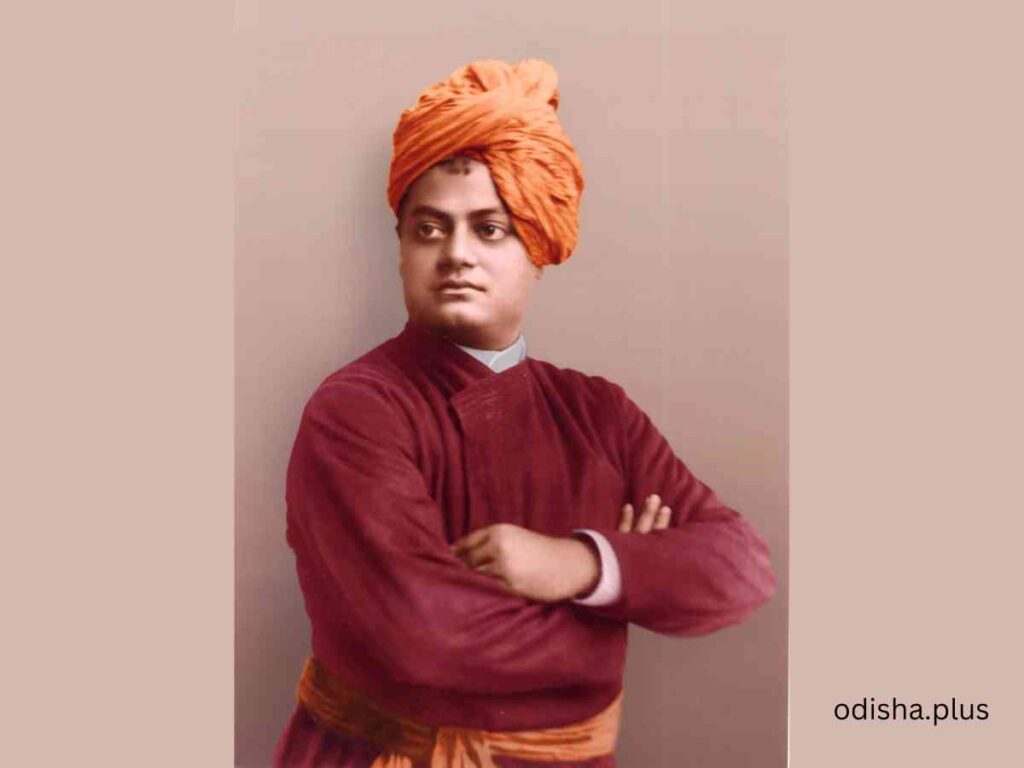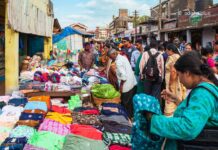India and America in the Eyes of Swami Vivekananda
Sailendra Pattnayak

“Yes, from the Land of Renunciation, I go to the Land of Enjoyment.” The young sanyasi murmured under his breath on the deck of the steamer Peninsular on that hot humid day, 31 May 1893, as the Bombay harbor and the coast line was receding back and vanishing from his tear-filled eyes. He was thinking of India, her cultural greatness, her sages and rishis, the Sanatana Dharma and great many scriptures, so also the terrible poverty that she has endured for centuries under the yoke of foreign rules.
Swami Vivekananda while remembering with great reverence the words of his Guru Sri Ramakrishna Paramahamsa which has made him to embark upon this journey to unknown lands of unknown people also has been listening to the voice of Sankaracharya who more than one thousand years ago had ‘caught the rhythms of the Vedas, the national cadence.’ How so ever the mission was clear in his heart. The time had come for the West to harken that ‘national cadence’ and the golden words of Vedanta. So the Swami was to arrive uninvited at the Parliament of World’s Religions to be held at Chicago, that new city on the banks of a sparkling lake and the symbol of the modern industrial power of America.
Like the marked antagonism of the words murmured on the deck of the steamer ‘Renunciation’ and ‘Enjoyment’, inherent in that occasion of the Parliament of World’s Religions a deep contradiction. It was organized as a part of the World Fair commemorating the 400th anniversary of the discovery of America or the so-called New World by Columbus.
To the West through the Deep East
Instead of traveling to West, after reaching Ceylon Swami Vivekananda traveled East. In China it was inspiring to discover many Sanskrit texts in Buddhist monasteries and in Japan he traveled extensively visiting the great temples of Buddha. Finally, on 25 July he arrived at Vancouver, Canada. From Vancouver he took a train on 26 July and via Winnipeg and Minnesota he arrived in Chicago on 30 July 1993. In Chicago, learning that the Congress will not be commencing before the second week of September, he proceeded to Boston as being invited by Prof. John Henry Wright of Harvard University who was an admirer of him through correspondence and also because Boston was cheaper to live then Chicago. So, on September 9, Swamiji reached Chicago for the second time.
The Great Planes of America
By this day since he had left Vancouver he seems to have traveled more than eight thousand kilometers by train and traveling by train certainly brings a greater intimacy of the place and people. While traveling the vast planes of America, Swamiji must have pondered of its past. And this was the landscape, only a hundred years ago, that has been dotted by the Native Red Indian habitations and roaming herds of bison. But surprisingly nowhere in his letters and other writings we find any mention of it. He seems to be speaking only of his contemporary America.
“The American civilization is in my opinion, a very great one. I find the American mind peculiarly susceptible to new ideas, nothing is rejected because it was new. It is examined by its own merits.’’ Howsoever he was aware of a staged enthusiasm in the day-to-day American life – “Nowhere have I heard so much talk about freedom – ‘life, liberty and pursuit of happiness’ – and nowhere is it less understood”.
The Columbus Legacy
In 1893 as the World Fair in Chicago was organized commemorating four hundred years of Columbus embarking on the soil of American continent. The war of USA government against the Native Red Indians or Amerindians was not still called off. There has been 1500 authorised wars, raids and attacks on the Natives. The last battle was in 1918, and at that time the Amerindian population had been reduced to 2,38,000 whereas in 1492 when Columbus had arrived between ten to fifteen million Amerindians were living within the territory that is today the United States of America.
The majority of the Native population had been wiped off by the diseases like smallpox, measles and flu. The viruses that were thriving in the densely populated semi urban regions of Europe and the viruses had come with the Europeans and as they landed on the American soil tore through the continent and finished off ninety per cent of the 55 million strong and healthy natives living across the great spread of the American Continent within next two centuries, the fifteenth and sixteenth century.
Subduing the Remaining Natives
So the above said wars, raids and attacks of the Govt. of USA against the remaining ten percent of natives has been to destroy their habitations and force them to take shelter within the specifically earmarked territories called ‘reservations’.
And for the purpose one of the strategies adopted by the Europeans settlers has been to destroy the sources of food. In 1492 the North American sky was teeming with birds, chiefly with pigeons numbering between three to five billion. In next four centuries the white settlers totally eliminated them with the last wild pigeon shot in 1901. The same was the fate of American bison. There were sixty million bison prior to 1800, in 1830 their number had come down to forty million and in 1900 only 500 survived.
The American Wealth and the Black African Slaves in USA
From the beginning of 16th century, European traders captured and purchased the black people of African continent and transported them in cargo ships to USA and for centuries it became the source of cheap labor for the plantations, firms and mines owned by the European settlers. By the time slavery was officially abolished in USA on 1st February 1865 more than 10 million black Africans had been transported to USA in cargo ships as cattle being transported and there is no record of the dead on the way whose bodies has been thrown into the sea.
So, it is never an exaggeration that while the American land belonged to the native Amerindians which the European settlers usurped by eliminating them, the American wealth was the creation of the Black African Slaves.
‘All Men Are Created Equal’
This famous quotation as part of the US Declaration of Independence which has been called an ‘immortal declaration’ was penned by Thomas Jefferson, the third president of the United States in 1776. Yet, Jefferson owned 5000-acre cotton plantations, on lands taken over by force from native Amerindian people and had more than 600 black African slaves working on his plantations. He also had a long-term relationship with a slave that started when she was fourteen and he was forty-four and fathered several children by her; and a child born to slave was also a slave by birth.
The Voice of Love from the Depths of Renunciation
It was evening of 9th September, Swamiji arrived Chicago, one day before the commencing of the World Congress of Religions. But unfortunately, he had mislaid the address of the committee in charge of the delegation and seeing it impossible to find help he passed the night in an empty freight wagon. Next morning hungry and thirsty he was walking the fashionable Lake Shore Drive with mansions of ultra-rich on both sides. Even to ask direction to the site of Congress was not possible as he was being driven away from the gates by the servants.
Realizing that he was in a land that knew thousands of ways of earning ‘almighty dollars’ hence all must be habituated in being dismissive of all possible ways of religious tramps and god’s vagabonds the one he must have looked like with his crumpled cloths and unshaved face. Exhausted and resigned to God he sat down on the side walk. And as it had happened time and again in his life, help came when all the reasonable expectations were being lost. The lady of the house in front was noticing him from the window and she being a friend to the President of the Parliament; after treating him with a sumptuous breakfast, she accompanied him to the offices of the Parliament.
The very first day of the Congress in the afternoon Swamiji representing Hinduism addressed the gathering – “Sisters and brothers of America, it fills my heart with joy unspeakable… I thank you in the name of the Mother of religions… in the name of millions and millions of Hindu people of all classes and sects….” The words captivated the audience in such a manner that there was full two minutes of standing ovation.
The Objectives Behind the Visit to America
While following the command of his master Sri Ramakrishna, he came to America ‘to bring the message of Vedanta to Western world’ and make the West understand the greatness of life based on the age-old principles of renunciation. Not only as a need for the harmony in the creation but also as part of the human journey to higher realms, so also, as he had informed his Gurubhais’ Bramhananda and Turyananda at Abu Road station while on his way to Bombay to board the ship, “to find means for the salvation of the poor of India – that I am going to America” since the people of India under the yoke of foreign rule has been impoverished to such an extent that bare survival of the body has become the sole occupation of the majority.
While Swami Vivekananda mainly had the two above objectives, and the third objective that had stemmed out of it, although remained unspoken, has been the freedom of India from the yoke of the foreign rule. After three years of his return to India in the meeting of monastic and household disciples on 1st May 1897 in Calcutta to discuss his plans of Vedanta work in an organized basis. Swamiji delineated the aims and ideals of Ramakrishna order which are of spiritual and humanitarian nature with completely disassociated from politics. But as it has been a known fact, in the critical years of Independence struggle the Belur Math had become the secret hub of the freedom fighters for inspiration and recuperation.
The Cruel Contradictions of History
Following the life and works of Swami Vivekananda it is imperative only that we could not be having any doubt of Advaita Vedanta, that living stream flowing through the millenniums, as in the modern era realized and personified by Sri Ramakrishna Paramahamsa, (i.e. the recovery of the truth of devotion, adoration and worship of God or Gods thus saving the primordial human innocence from the excessive transcendental aspect of Vedanta) happens to be the highest realization of humanity and in our time this great gift of the East was taken to the West by Swamiji.
Yet such have been the cruel contradictions of history that those two races – the native Amerindians and the Black Afro-Americans who has been victimized so that European colonizers make themselves rich and make the United States America emerge as a super power dominating the world, could hardly part take in it. Even a token representation from those two suffering races in the Congress was not possible.
The Blundering Post-Independence-Indians
In the similar vein while Swamiji’s contribution in making India aware of its inherent greatness and her right to independence, while making Sri Ramakrishna Mission famous for its philanthropic work and the Sri Ramakrishna Math greatly inspiring as an Order of Sanyasis devoted to spread the Vedanta and teachings of Sri Ramakrishna remains unparalleled; his dream of India as the inheritor of Vedic and Vedantic wisdom serving as the beckoning light of soul-power to the world seems to have remained unfulfilled.
In spite of his English education and his firsthand experience with the West he could not have imagined the way the shrinking of mind the western education coupled with the concept of secularism would cause to the generations of post-independence Indians. In the same breath his dream of Vedantic Hinduism growing ever in its all-inclusive broadness with the corrective measures setting right the historical blunder of castigating a portion of itself as fallen and ‘untouchable’ remained unfulfilled.
That unattended blunder in post-independence India compelled Dr. Ambedkar to divert a mass of Dalits to Buddhism which in the long run not only failed to serve either of the stakeholders, in a later period it seems to have helped a section of Hindus with self-interest to constrict further the greatness of Hinduism. In the same manner given to the narrow interpretation of secularism and same time given to the subliminal inheritance of the inclusive attitude of the educated Indians, in the post-independence India a very great number of the forest dwelling tribal communities could not be protected from getting converted to Christianity.
And finally was it not a cruel mischief of history that in 1993, the centenary year of Vivekananda’s heroic address at the World Congress of Religions, India opened herself to the Free Market Economy and thus initiating her citizens in the consumerist culture of America or as Swamiji called it the ‘Yankee Land’!
(The author is a poet, spiritualist and development professional. Views expressed are personal)
#SwamiVivekananda #SpiritualWisdom #Swamiji



























